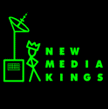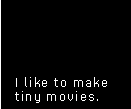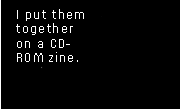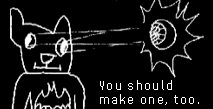            |
CD-Riffic!
Jim Munroe
Doing a video
zine on CD has a few advantages to doing one on VHS tape —
it's quicker to burn a CD (about 10 minutes on an 8x), it's cheaper
to make (maybe fifty cents per blank CD-R), and it's cheaper to
mail (the price of a letter). The disadvantages are that VCRs
are still more common than fast computers & if you don't have
a newish computer, they're pricey. That said, if you want to toy
around with the format, here's how I go about making my zine,
Novel Amusements.
1. First,
I get all the material together. Usually it's in different formats
— VHS tapes, DV tapes, CDs. It's hard enough to get people
to send in vids, forget trying to get them to submit them in the
proper format. I have access to a DV camera, so I transfer the
analog to a DV tape via the red/white/yellow RCA cable and then
firewire it to my harddrive.
2. When it's
on the computer, I convert them all to the same format using Premier
or MediaStudio Pro. (I've used different formats in the past but
it wasn't compatible with a lot of computers, to I stick to MPEG,
15 frames per second, 320x240 frame size.) This format takes up
about ten megs on the CD per minute, which means a 700meg disc
can hold about an hour of video.
3. I like
to make the discs compatible with Mac, PC, and Linux and pretty
easy to use, so I make a simple interface that all systems are
used to dealing with: HTML. I build a web page with single frames
of the video (Premier has a Save Frame function) that are directly
linked with the .mpg files, so you just click through to watch
the video. Follow the KISS rule here — every time I've tried
to put window dressing on the interface (ie. sound effects) it's
fouled up when I've tested it on other machines. When I was done
with #2, it looked like this. Feel free to use/abuse the HTML
code for #1 and #2,
or load it into an app like Dreamweaver to customize it for your
zine. Just send me a copy! (Violating the aforementioned "keep
it simple, stupid" rule for #3, I decided to embed the vids
in a html page instead of linking directly to the .mpeg files.
I used this javascript
that makes it run on Quicktime with Macs and Windows Media Player
on PCs. [Note: this script works well on a CD platform, but not so well online for some reason.] WMP was preferable when available because it goes fullscreen
easily, but QT is so much more common and reliable on Macs.)
4. Once I
have a working interface on a folder on my local computer, it's
time to burn it onto a disc. Since I want it to be cross-compatible,
I got a program called CDEverywhere
to create an ISO image of the files I want on the disc. CDEverywhere
also lets you choose stuff like Autorunning a file on Mac or PC,
so it automatically opens up when you put it in the drive. Then
I get Nero (a
CD burning software package) to Burn Image. I burn a few copies
and see how they work on different computers, and adjust accordingly.
Testing is more of a big deal if you're pressing a whole bunch
at once, since if you're burning them one by one you can refine
it. (One of the things I tried to do with the last two was make
it playable on a DVD player — you can get Nero to translate
MPEG files to a file format (VCD) that will allow most newer DVD
players to run it. One way I could see to do it was to duplicate
the files and name them specially for DVD, and that would have
drastically cut down the number of vids I could put on. I've also
gotten PCs to read the .DAT files that VCD requires the videos
to be in, but couldn't get Macs to do it. Getting a disc to run
on PC/Mac/Linux/DVD has become a bit of a holy grail for me, so
let me know if you have
any ideas!
5. With the
first one, I burned about 300 of them over a few months, just
making more as I needed them — usually letting them burn
in the background while I did e-mail or whatever. I bought them
100 at a time, blank, for 30 bucks, and then made stickers for
them. I slipped them into paper bags and sold them at zine fairs
and whatnot for $3. With the second one, I wanted to press a bunch
at once, so I called a few places for quotes on pressing a CD
(a different process from burning, technically, but with the same
end product). In the end, I got a CD duplication place to do 2000
discs (with 2-colour on it) inserted in full-colour cardboard
sleeves (more expensive then jewel cases, but so much cooler)
for around $2000. I wanted something that would be less labour-intensive
and more polished, so I was happy with that, but for a first timer
burning is a cheaper and safer option.
Jim Munroe runs this
site and does a CD-ROM zine called Novel Amusements.
|







